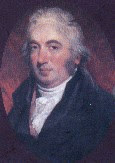 Henry Singleton, with John Crosdill and William Shield, was a witness to John Fuller's 1823 will. Singleton, however, is the only one of the three who outlived Fuller and received a bequest of £100 and " a ring of twenty guinea value."
Henry Singleton, with John Crosdill and William Shield, was a witness to John Fuller's 1823 will. Singleton, however, is the only one of the three who outlived Fuller and received a bequest of £100 and " a ring of twenty guinea value."Jack Fuller sat for a portrait by Singleton in which he looks every bit the Georgian Squire. On the desk at his elbow is a letter addressed to John Fuller, Esq., MP, Rose Hill, Sussex dated June 10, 1806. The painting was presented to the Royal Institution in 1932 and was installed on the upper level of the Grand Staircase, where it still hangs, [ see detail on left side bar]. Singleton published a mezzotint print of the portrait, engraved by Charles Turner [seen here right], on 18 July 1808.
Singleton was born in London, England on 19 October 1766. He died in London, at the house of a friend at 7 Kensington Gore, on 15 September 1839, and was buried in the church of St Martin-in-the-Fields, London.
From the age of sixteen, Henry Singleton worked as a professional portraitist. He attended the Royal Academy Schools from the age of seventeen and won the silver medal in 1784. His painting from John Dryden’s ode Alexander’s Feast won the gold medal in 1788. In 1793, he was commissioned by the Royal Academy to paint a group portrait of forty of the academicians. Ironically, Singleton never became a member or an associate of the Academy himself. Early in his career, Singleton was noted for large compositions from the Bible, Shakespeare or contemporary historical events. Although his portrait work was always in demand, he never achieved the great success as a historical painter that his early promise showed. Lord Nelson, Admiral Vernon, Lord Howe and John 'Mad Jack' Fuller are among his portrait sitters. Paul I Granting Liberty to Kościuszko (1797) and The Death of Captain Alexander Hood after Capturing the French 74 ‘L’Hercule’ (1798) are considered by some to be his best works. Shortly before his death, he completed a series of cabinet pictures to illustrate the works of Shakespeare [above is an excerpt from the article I wrote for Wikipedia].


No comments:
Post a Comment